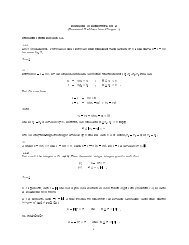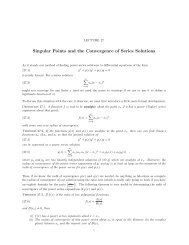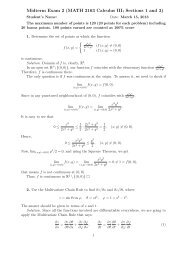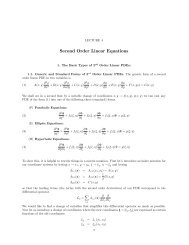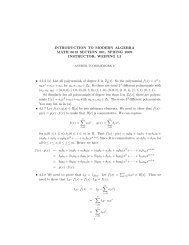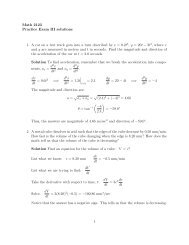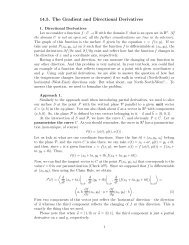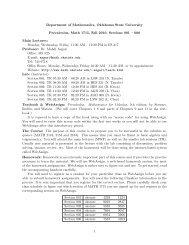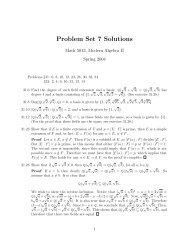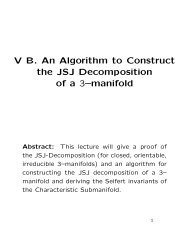Reverse Triangle Inequalities for Riesz Potentials and Connections ...
Reverse Triangle Inequalities for Riesz Potentials and Connections ...
Reverse Triangle Inequalities for Riesz Potentials and Connections ...
Create successful ePaper yourself
Turn your PDF publications into a flip-book with our unique Google optimized e-Paper software.
Proposition 3.1. For 0 < α ≤ 2 <strong>and</strong> any compact set E ⊂ R N there holdsM N−α (E) = W α (E). (10)Indeed, given a unit Borel measure µ, Frostman’s theorem <strong>for</strong> such α <strong>and</strong> E gives∫ ∫inf U α µ ≤ U α µ dµ α = U µ αα dµ ≤ W α (E),Eso that M N−α (E) ≤ W α (E), which together with Ohtsuka’s inequality yields (10). Alternatively,one can deduce (10) by observing that <strong>for</strong> the given range of α, a maximum principleholds <strong>for</strong> the equilibrium potential <strong>and</strong> appealing to Theorem 11 of Farkas <strong>and</strong> Nagy [10].Bounds on the quantity Mm N−α (E)/m <strong>and</strong> the sets A m which achieve the maximumin MmN−α (E) have been the subject of several recent papers [9, 12]. The reverse triangleinequality in Theorem 2.3 is directly connected with MmN−α (E)/m in the case of atomicmeasures. Recall that the inequality (9) holds <strong>for</strong> arbitrary positive Borel measures ν j suchthat ∑ mj=1 ν j is a unit measure. We now introduce a similar inequality where each ν j = δ xj /mis a point mass 1/m supported at x j ∈ E:1mm∑j=1inf |x − x j| α−N ≥ CE(α, δ m) + 1x∈E m infx∈Em∑|x − x j | α−N ,where CE δ (α, m) denotes the largest (best) constant such that the above inequality holds <strong>for</strong>all {x j } m j=1 ⊂ E. Clearly, we have CE δ (α, m) ≥ C E(α, m).From the definitions of CE δ N−α(α, m) <strong>and</strong> Mm(E) we immediately deduce that <strong>for</strong> allα < N,maxA m⊂E1mm∑j=1d α−NE(x j ) − M mN−α (E)mIn particular, if E is the unit sphere S N−1 ⊂ R N , we have2 α−N − M N−αm (S N−1 )mj=1≥ C δ E(α, m).= C δ S N−1 (α, m). (11)In [12], it is proved that <strong>for</strong> the unit circle T = S 1 the maximum polarization <strong>for</strong> any m ≥ 2is attained <strong>for</strong> m distinct equally spaced points. Moreover, this maximum, which occurs atthe midpoints of the m subarcs joining adjacent points is known explicitly (in finite terms)when N − α is a positive even integer, <strong>and</strong> asymptotically <strong>for</strong> all −∞ < α < N. Therebywe obtain the following.Proposition 3.2. For the unit circle T = S 1 there holds, <strong>for</strong> all −∞ < α < 2,C δ T(α, m) = 2 α−2 − M 2−α (A ∗ m, T)m= 2 α−2 − M m2−α (T)m , (12)where A ∗ m = {e i2πk/m : k = 1, . . . , m}. Moreover the following asymptotic <strong>for</strong>mulas hold asm → ∞ :8



